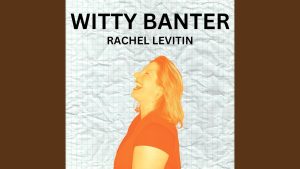
Witty Banter is One for the Books
Recent Articles March 21st. A day that I will always think of amazing album releases. DC-based musician, producer, and singer-songwriter, Rachel Levitin, released Witty Banter

by Michael J. West
On February 25, D.C. jazz fans got a rare treat at Georgetown’s Blues Alley: the debut of a brand new big band. The KW big band features 18 musicians, who collectively perform the compositions and arrangements of guitarist Michael Kramer and pianist Tim Whalen, who also lead the band and provide the titular initials.
The music they played on their first gig was complex stuff. Tunes were long, labyrinthine, and sometimes unwieldy, with multiple sections and phrasings that were audibly technically challenging. They used odd meters, too: Whalen’s pretty “Long Walk,” probably the centerpiece of the evening’s first set, and Kramer’s subsequent, bass-driven “Identity Politics” were in mind-boggling 13/4 and 9/4 times. Or they would have been mind-boggling—if the material hadn’t been so alluring, the ensemble so polished, the rhythm so smooth and swinging.

That, say Kramer and Whalen, is really the point of what they do. “Even if it’s super complicated, it still needs to feel good,” Whalen explains, sitting next to Kramer at a lunch date in Washington’s Woodley Park neighborhood. “I’m sure you’ve heard a lot where the rhythm gets to be more like a math project. So it’s important to us to find that overarching flow, and to do it very musically.”
“When we were rehearsing ‘Long Walk,’ Tim told the guys, ‘Don’t count! Don’t count!’” Kramer recalls. “’Don’t think it, just feel the groove, Just remember what it sounds like.’” That’s how I feel about it, too.”
Traditionally, big bands fall into two camps. Some are repertory bands, designed to put new life into existing large-ensemble arrangements. The others are outlets for new work by ambitious composers. KW falls into the latter camp: a vehicle that allows Kramer and Whalen to hear and to workshop their own writing. “It’s a playground to keep improving,” Whalen says.
Both composer-bandleaders are veterans of D.C.’s extension of the U.S. Army band. (Most of KW’s members are military musicians: There were a lot of regulation haircuts on Blues Alley’s stage.) Kramer is a member of its jazz ensemble, the U.S. Army Blues; Whalen is part of the rock combo, Downrange, and sometimes substitutes in the Blues, where the two got to know each other. Each wrote for the band, and each recognized and appreciated the other’s writing ability. In 2016 they put on a joint recital of their music at the Army Band’s theater facility.
“We both decided that we wanted to continue that experience,” says Kramer.
One of their most important realizations was that they had complementary composing styles. Whalen liked funky grooves and intricate section parts; Kramer wrote in a more cinematic, unfolding-melody style. Both had a passion for linear, nonrepetitive compositions that (in the guitarist’s words) “totally explode the song form.” It gave their music variety and range, but also a through-line that lent a common identity to both composer’s music.

When it came to putting the band together, they leaned toward the musicians they’d worked with most frequently—which meant military musicians. “It’s people we know and are comfortable with,” Whalen explains. “We can call these people, they’re gonna be prepared, they’re gonna look at the music, they’re gonna be on time. I work with people on the outside all the time, but when it comes to having a huge group—herding 18 people is not easy! You want to have that group of people that you really understand.”
That influenced their writing as well. Apart from employing celebrated soloists like saxophonist Tedd Baker and trumpeter Graham Breedlove, they carefully considered the players of written parts. “When you have someone like [drummer] Steve Fidyk in the band, or [second alto saxophonist] Joseph Henson, you don’t write a second alto part, or a drum part. You’re writing for a part for Joseph, or for Steve.”
Even after assembling a reliable group of musicians, though, it took a while to get everything together. Eighteen-piece orchestrations didn’t happen overnight, for one thing; for another, each of the members is a busy professional musician, and long-range planning was necessary to find a time when everyone was available. Even when the gig was booked, there wasn’t much time to prepare: KW had exactly one rehearsal for their Blues Alley debut, and it was on the afternoon of the show.
“It was the gig that established the group,” Whalen says.
There will not be a heavy schedule of such gigs, though. “We’d like to play, I’d say two or three times a year,” says the pianist. “I would rather play less gigs and try to make a bigger deal out of each one than just be playing constantly.”
“You can oversaturate,” Kramer adds. “This scene is a very vibrant scene, but even if Pat Metheny were to come and play at the Hamilton every week, he wouldn’t sell that out every single week, so how can Tim and I do that? Pat Metheny or Scofield comes to the Hamilton once a year, say for the DC Jazz Fest, and it’s packed. So we’re looking to have that kind of model, where we can fill a room full of people with this music. We can have new material every time out if we do that, too.”
Not that the already-prepared material will just be discarded now that it’s been played. “The next step is that we’re gonna record all this music,” says Whalen. The duo had originally intended their premiere to be a rehearsal for a recording session; that didn’t pan out, but they plan to launch a crowdfunding program and lay down their 14 current pieces in Whalen’s home studio.
In the meantime, though, they are excited and encouraged by the reception that the band got at Blues Alley. “This has never happened before,” says Kramer. “There were two or three instances where the audience actually clapped, not after a solo, but after an ensemble section. That’s what our band is about.”

Michael J. West is a freelance writer, editor, and jazz journalist who has been covering the Washington, D.C. jazz scene since 2009. He spends most days either hunkered down in the clubs or in his very big headphones. He lives in Washington with his wife and two children.

Recent Articles March 21st. A day that I will always think of amazing album releases. DC-based musician, producer, and singer-songwriter, Rachel Levitin, released Witty Banter

Alchemical Records is a Washington, D.C. based music publication. We cover the Washington, D.C., Baltimore and Richmond, VA metro area music scenes, including band interviews, articles about your favorite musicians, new music and concert dates.